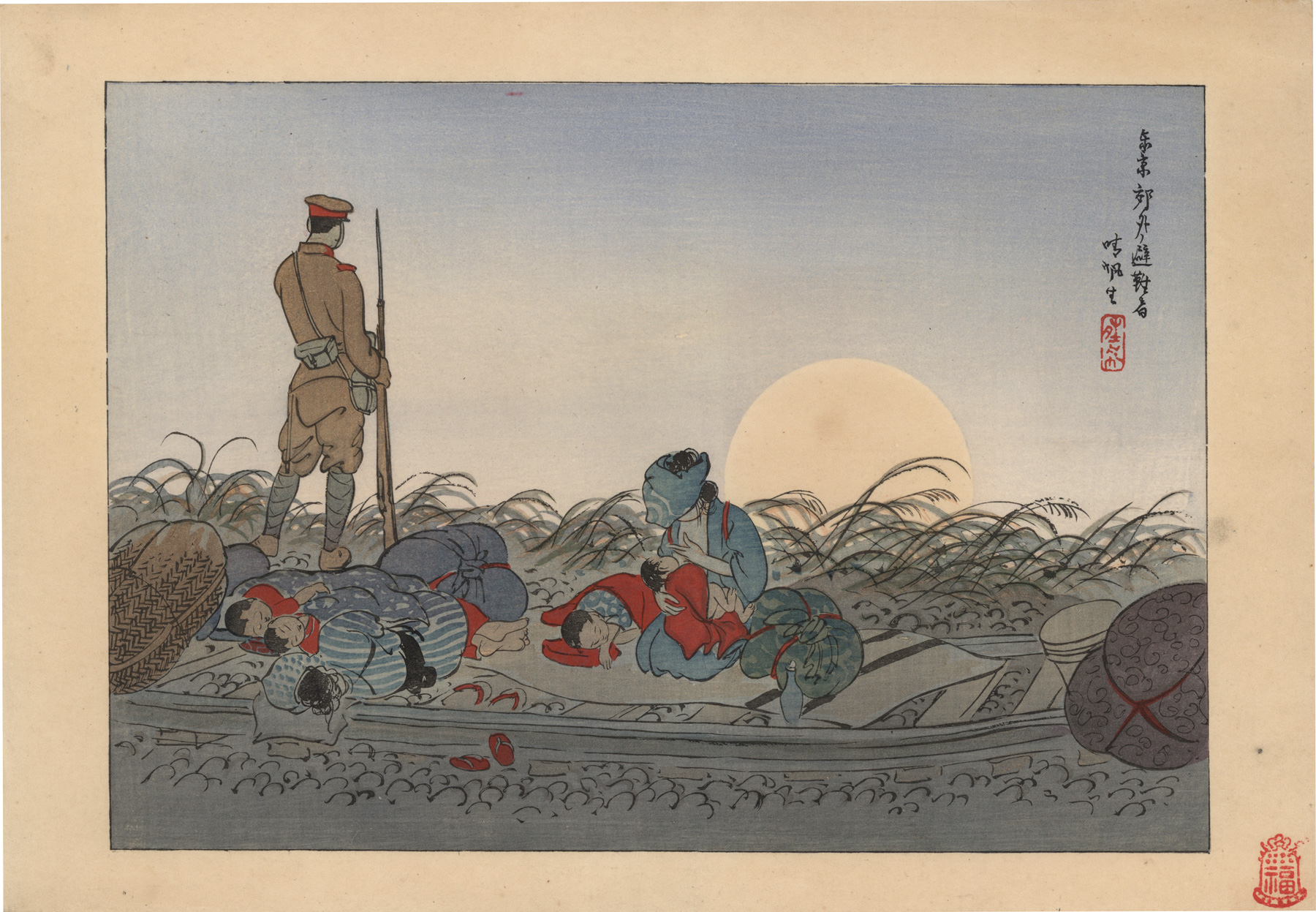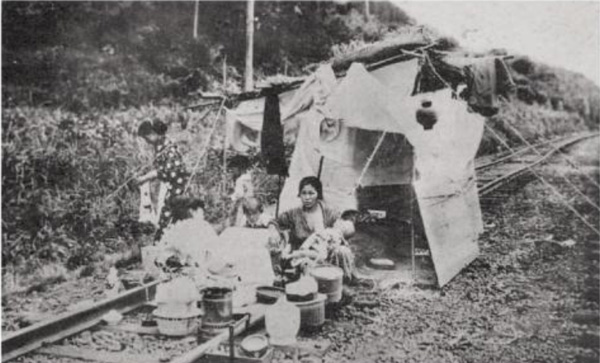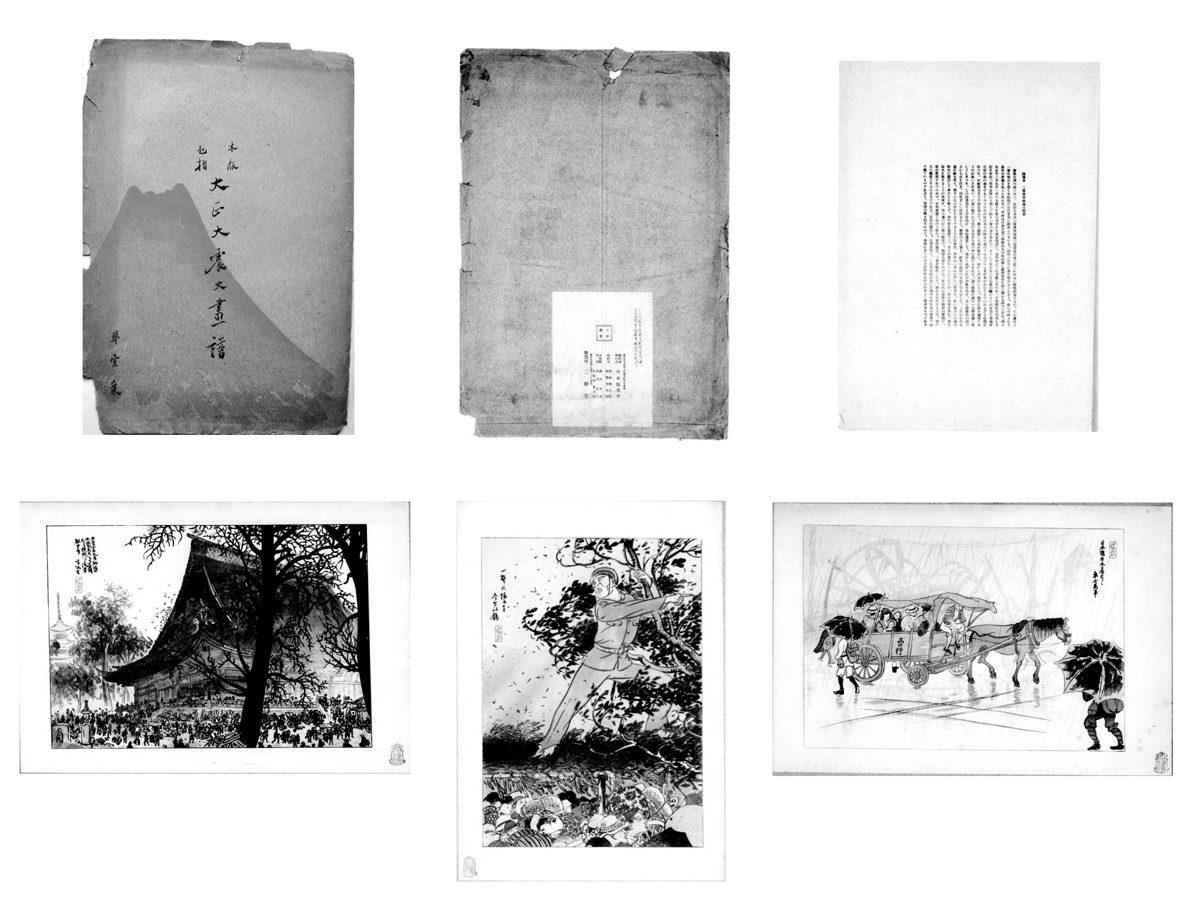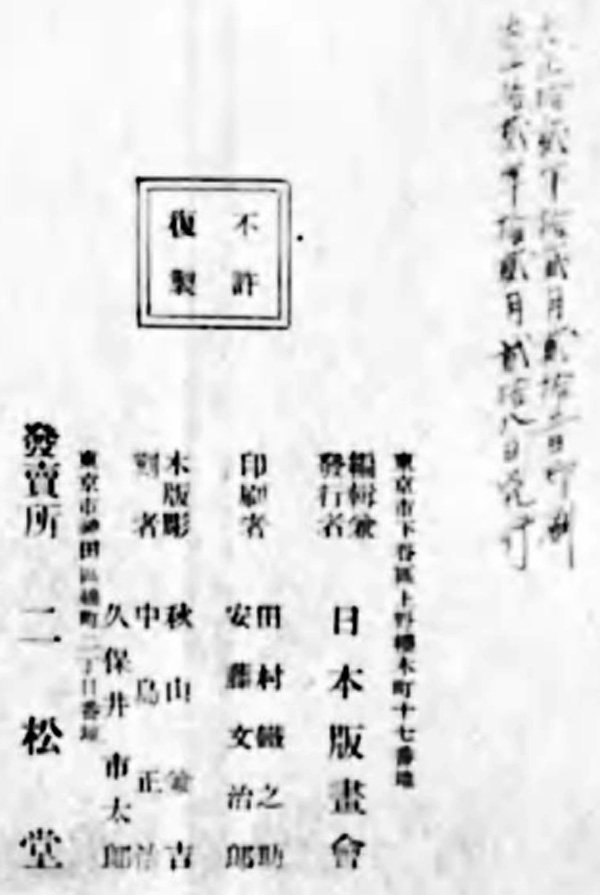About This Print
A poignant scene of young children and their mothers camping on railroad tracks on the outskirts of Tokyo following the 1923 Great Kantō Earthquake. A single solider stands guard as the moon rises. The quake was so violent that even the railroad tracks were bent by its force. "One frequently reproduced photograph [see below] shows a mother breastfeeding her infant in a makeshift camp that she has erected on the presumably defunct railway tracks."1(Kantō Daishinsai risaisha no awarena jōtai), postcard, 1923. Ishii Toshio Collection.2
About the Album
I have not been able to confirm how many prints were issued as part of Color Woodblock Picture Album of the History of the Taishō Great Earthquake, Collection 1 or whether their were subsequent collections issued. The information that is available can be found on the National Diet Library website. The NDL displays three prints, a single explanatory sheet (for the Private Nakamura print), and the front and back of a dismembered envelope which contained the prints. A colophon is pasted to the back of the envelope. (See details below.) It is not known whether the three prints the NDL shows are all that were originally contained in the envelope. In addition to the three prints shown, a fourth print, belonging to this collection, Evacuees in the Suburbs of Tokyo, is known.Unfortunately, the NDL reproduction of the colophon is not clear and can only be partially read, as shown below.
編輯兼 発行者 日本版畫會 Editor and Publisher: Nihon hangakai [Japan Print Association, preceded by Tokyo address]
印刷者 田村鐵之助 安?女治郎 Printers: Tamura Tetsunosuke (1853-1925) and unread
刻者 中島正尚 久保井市太郎 Engravers: unread and Kuboi Ichitarō
東京市神田區錦町二丁目十番地 發賣所 二松堂 Sales Office: Nishōdō [preceded by Tokyo address]
image source: National Diet Library website
Strangely, the colophon does not contain Fukunaga Seihan's name 福永晴帆 and neither the NDL or the Tokyo Metropolitan Library, which shows a single print, that of Private Nakamura, lists him as the creator. The presence of two seals appearing on all four prints reading 晴帆 (seihan) and 福 (fuku), coupled with the information contained in the magazine The Studio: An Illustrated Magazine of Fine and Applied Art,which positively attributes the prints to him, establishes Fukunaga, best known for his paintings of sliding screens, as the artist.
1 Imaging Disaster: Tokyo and the Visual Culture of Japan's Great Earthquake of 1923, Gennifer Weisenfeld, University of California Press, 2012, p. 192.
2 ibid. p. 193, fig. 5.24.
Print Details
| IHL Catalog | #1301 |
| Title or Description | Evacuees in the Suburbs of Tokyo 東京郊外の避難者 Tokyo kōgai no hinansha |
| Series | 木版色摺 大正大震史畫譜 Taishō daishinshi gafu mokuhan irozuri Color Woodblock Picture Album of the History of the Taishō Great Earthquake also transcribed as 木版色摺 大正大震火画譜 Taishō daishinka gafu mokuhan irozuri note: it is unknown what "collection" this print was part of. |
| Artist | Fukunaga Seihan (1884-1961) |
| Signature | not signed |
| Seal |   left: seal reading 晴帆 Seihan right: 福 (in seal script) [possibly a seal of the artst Fukunaga Seihan or, simply a seal of "good fortune".] |
| Publication Date | 1923 (Taishō 12) |
| Carver | |
| Printer | |
| Publisher | 日本版畫會 Nihon hangakai [Japan Print Association] |
| Impression | excellent |
| Colors | excellent |
| Condition | good - toning and soiling; full-size sheet |
| Genre | shin hanga |
| Miscellaneous | |
| Format | oban |
| H x W Paper | 10 3/16 x 14 13/16 in. (25.9 x 37.6 cm) |
| H x W Image | 8 9/16 x 12 3/8 in. (21.7 x 31.4 cm) |
| Literature | The Studio: A Magazine of Fine and Applied Art, Vol 91, No. 397, April 15, 1926, p. 254. |
| Collections This Print | |
5/21/2021
10/30/2020





